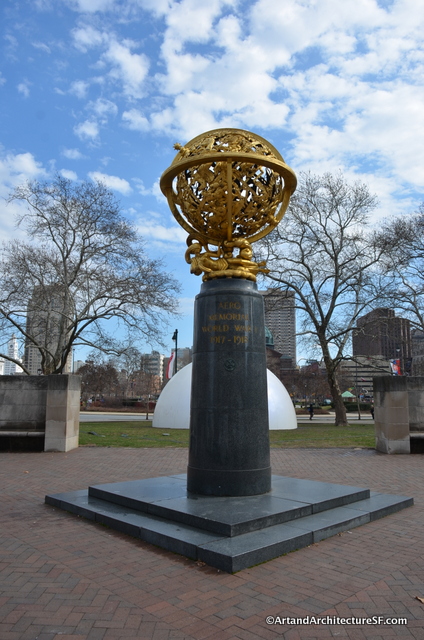
Philadelphia has the largest collections of Public Art in the United States and much of it can be viewed with an audio tour
I was particularly drawn to this bronze sphere which sits opposite the main entrance of the Franklin Institute and is dedicated to aviators who died in World War I. Inscribed with the Latin names of constellations and planets, this Paul Manship sculpture Aero Memorial illustrates the signs of the zodiac in a style that recalls both classicism and Art Deco.
The idea for Aero Memorial was conceived by the Aero Club of Pennsylvania, which donated modest funds for the purpose to Fairmount Park Art Association (now the Association for Public Art) in 1917. Fundraising took many years and the work did not begin until 1939 when the Art Association contacted Manship.
 By the time he was fifteen years old, Paul Manship had decided he wanted to become a sculptor. Born in 1885, in St. Paul, Minnesota, Manship attended Mechanical Arts High School, he also took evening classes at the St. Paul Institute School of Art but left to work as a designer and illustrator.
By the time he was fifteen years old, Paul Manship had decided he wanted to become a sculptor. Born in 1885, in St. Paul, Minnesota, Manship attended Mechanical Arts High School, he also took evening classes at the St. Paul Institute School of Art but left to work as a designer and illustrator.
In 1905 he enrolled in the Art Students League in New York City and after a few months of formal study became an assistant to the sculptor Solon Borglum, whom he considered a critical influence on his work. After further study, he received a three-year scholarship to study in Rome where he fell under the spell of Greek antiquity and the beauty of classicism. He traveled extensively before returning to the United States in 1912 launching a career that would last fifty years.
 “I like to express movement in my figures. It’s a fascinating problem which I’m always trying to solve,” he said. He also noted, “I’m not especially interested in anatomy, though naturally, I’ve studied it. And, although I approve generally of normally correct proportions, what matters is the spirit which the artist puts into his creation—the vitality, the rhythm, the emotional effect.”
“I like to express movement in my figures. It’s a fascinating problem which I’m always trying to solve,” he said. He also noted, “I’m not especially interested in anatomy, though naturally, I’ve studied it. And, although I approve generally of normally correct proportions, what matters is the spirit which the artist puts into his creation—the vitality, the rhythm, the emotional effect.”
Some of Manship’s well-known works are the Prometheus Fountain in Rockefeller Center, the gates to the entrances of the Bronx Zoo and the Central Park Zoo, and the Time and Fates Sundial and Moods of Time sculptures installed in front of Trylon and Perisphere at the 1939 World’s Fair in New York City.
